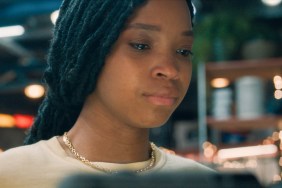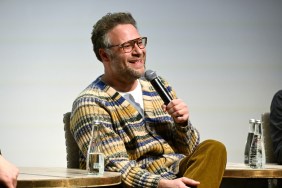Steven Quale, a James Cameron protege whose credits grew from production assistant on The Abyss to, eventually, second unit director on Titanic, surprised a lot of audiences in 2011 with his solo directing debut, Final Destination 5. Now shockingly well regarded for what appeared on the surface to be just another attempt at a fading horror franchise, Final Destination 5 delivered an inspired take on the series beloved for both its stylish special effects gore and its wickedly clever twist ending. Now, with Into the Storm hitting theaters on August 8, Quale is getting ready to deliver his sophomore feature, a disaster thriller that trades in Final Destination‘s supernatural terror for true-science horror, imagining an all-out weather worst-case-scenario that hits a small town, unfolding over the course of less than a single day, primarily told through three intertwining stories.
ComingSoon.net paid a visit to the Michigan set some time ago to chat with Quale and the cast and crew of what is now lined up to become a summer blockbuster. You can read on to learn more about the characters, the storytelling multi-structured narrative and the film’s slight “found footage” element. Those planning on going in 100% spoiler free, however, should be prepared for a more drama-heavy take on than Quale’s Final Destination 5 film, upping that franchise’s villain, the impish Death, with a similarly non-personified all-out wrath of God.
Set in a small Tornado Alley town, Into the Storm begins with a high-school’s final half-day of the semester, ending early to allow for the seniors’ graduation ceremony. That’s when the weather begins to take a decided turn for the worst. The first of the three stories has The Hobbit‘s Richard Armitage starring as Gary Morris, Vice Principal/English teacher of Silverton High School. He’s got two kids of his own, Nathan Kress’ Trey and Max Deacon’s Donnie, who are attending the graduation ceremony.
“Through the story, Gary?s mission is really to try to find out where his son has got to,” Armitage tells us in the back of a small shop in the suburbs of Pontiac Michigan. It’s temporarily closed while the small-town mainstream outside doubles for a key moment in the film where several of the narratives intersect. “?[H template=’galleryview’]–>e?s got Trey with him, so he’s trying to juggle two things. He’s protecting the older son and he’s going in search of the younger son.”
Since the script already had Morris’ jobs doubled up for the small high school, Armitage added his own character element to help make his character’s more action hero-minded role seem a bit more grounded.
“I kind of decided as we were shooting that he was also the football coach,” Armitage says, “because I needed kind of a level of fitness that wasn’t particularly extraordinary, but the ability to run and kind of shout quite loudly. Then it was the dialect coach told me, ‘You do sound like you coach the football team!’ So I said, ‘Okay, that will go in the biography as well!'”
There’s another twist to the three stories of Into the Storm: each embraces a first-person camera perspective. In the case of Morris and his sons, the action is revealed through a tape that Kress’ Trey has been tasked to make of the graduation ceremony.
“One of the reasons why Trey comes with me is because he has the camera,” says Armitage, “But of course you have to?that’s the game of the film. You have to acknowledge that and then ignore it. But each camera becomes a character. There’s times where my son isn’t in the scene, but his camera is and I have to talk to him as if he’s there. But it’s a camera operator. So each camera becomes a character.”
“He’s kind of the rebel black sheep of the group,” Kress puts it. “He doesn’t really take anything seriously. He’s very immature as the movie starts and he always gives his brother a hard time. But you can tell they have a very good relationship. But his relationship with his dad is very strained. As the movie progresses, the relationship between Gary and Trey changes quite a bit because they’re forced to go together on this journey through this ridiculous disaster.”
It’s far from just three cameras, however. The general rule is that every scene comes from a real-world camera somewhere. That, Armitage says, presents itself with its own very set of acting challenges.
“Some of them are surveillance cameras,” he smiles. “So you have to know very specifically that you don’t start talk to a surveillance camera like it’s a person. It’s very unusual.”

The next major storyline involves a team of professional storm chasers filming their top-end reality series. There, the footage comes from the point of view of the documentary crew, who travel in a “tornado-proof” vehicle called Titus.
“I’ve been on the road chasing storms for at least ten years,” says Matt Walsh, who plays a non-comedic role as Peter, the leader of the show’s crew, “and I put together what I think is a vehicle that can actually dig into Earth and capture the shot that no one has captured, which is the center of the tornado. The eye of the tornado.”
Also on the crew is Sarah Wayne Callies’ Allison Stone, the team’s meteorologist.
“She’s your source of exposition,” laughs Callies. “She’s a professor of climatology and meteorology, so I got to look up 30 words I’d never seen before. I now wake up and literally start watching ‘The Weather Channel.’ It doesn’t go off until I leave.”
Stone also dreams of getting readings from the center of a tornado, but winds up butting heads a bit with Peter and his way of going about things.
“The tension between our characters is, from my perspective, because his character’s an *sshole,” she says. “But no, it?s a relationship between a woman of science who’s job it is to get some data and a bit of a maverick filmmaker who is willing to take much bigger risks. And I think from her perspective he can take all the risks he wants, but she feels responsible for the lives of everybody involved.”
Of course, the second narrative quickly becomes intertwined with the first when Armitage’s Morris crosses paths with the Stone character.
“Part of the story is that Alison really assists Gary in finding his son,” says Armitage. “?they?re both single parents and I think that relationship is probably the strongest relationship. It’s not a manipulated relationship.”
Also on documentary crew’s team are Arlen Escarpeta’s Daryl, a tech-smart camera guy and Jeremy Sumpter’s Jacob. Daryl’s somewhat of a seasoned pro behind the lens while Jacob has just gotten the job thanks to his buddy’s connections.
“I’m the rookie of the team,” says Sumpter. “I make a lot of mistakes. My character is new to this stuff, but [Daryl template=’galleryview’]–> is my best friend. He’s got sympathy for me. Allison, she’s a nice lady and she has sympathy for me. But Pete, oh man no!”
Unfortunately for Sumpter, his character’s traits spilled out a bit into reality.
“I actually broke one of the cameras,” he grimaces. “The eyepiece broke off the camera, it fell off the Titus.”
Escarpeta, meanwhile, got to operate a steadicam rig in-character. The final film may actually make use of footage he shot under simulated weather conditions.
“I hope makes it into the movie,” he says, “because it was incredibly hard, but it was also fun. I felt like I got it toward the second or third take? If it makes it in there I’ll be very excited.”

The third and final narrative revolves around the general community of Silverton and very different film crew: a distinctly less professional webshow, filmed by and starring Kyle Davis’ Donk and Jon Reep’s Reevis.
“It’s obvious that we’re trying to get rich and get girls by becoming a ‘Jackass’ Johnny Knoxville type, but on the YouTube world,” says Reep. “It looks like another opportunity for us to possibly get rich or something.”
“[W template=’galleryview’]–>e actually probably didn’t think anything of the tornado,” laughs Davis, “until we saw these tornado chasers and went, ‘Oh s–t! Let?s give that a try! Why not? We already tried everything else!”
“If you’ve ever seen a documentary about Katrina, some people are just drinking,” explains producer Todd Garner, “so the Donk and Reevis characters came from guys who were just having a hurricane party. ‘We’re going to drink beers!’ Some people just do that.”
Donk and Reevis tend to follow the professional storm chasers’ Titus in their own specially-designed vehicle: a beat-up old truck protected with plywood.
“We run into these guys a lot,” says Walsh. “They’re annoying and not safe and they think it’s easy.”
The three stories cross over with one another quite extensively, unfolding over the course of just a few hours.
“[A template=’galleryview’]–>s a result,” Quale explains, “you kind of have this parallel story of these three things going on, all converging at the end? and seeing the sort of awe and beauty and the horrific force that these tornados can inflict upon us.”
The tight timeframe was important for Quale, too, because he’s aiming to capture a sense of rapidly-building intensity. He’s also well aware that some people are going to compare the film to Jan de Bont’s 1996 tornado thriller, Twister.
“‘Twister’ was a great movie,” says Quale, “but it?s been a few years. It was ’96. That was quite a long time ago? Imagine the difference with the ability of the visual effects to show the devastating effects of a tornado in a downtown square as opposed to way out and seeing one barn go up. We’re there when a high school with a thousand students, faculty and parents at a graduation ceremony, a tornado is coming right at them, they have to rush into the storm shelter section.”
Although some of Into the Storm‘s spectacle is being constructed out of top-notch CGI effects, a great deal of the storm conditions were recreated on the set with wind machines that would shoot water and bits of debris at the actors as they filmed their scenes.
“You’re faced with a whole other set of discomfort,” says Armitage, comparing his role to his makeup-heavy performance as Thorin in The Hobbit films. “[You’re template=’galleryview’]–> constantly wet and effectively standing in front of a jet engine from a Boeing 747 for two weeks. Out of the frying pan and into the fire!”
“I did wire rehearsal where they put me in a [harness template=’galleryview’]–>,” recalls Callies, “and then they just had me walk in a straight line at the hundred mile an hour fan. Really, it’s extraordinary and they just blew me right off my feet. Then they would kind of stabilize me and bring me back down. I kind of love that stuff, you know? When the car flips and guns and wires and big explosions. I dig that. It’s really fun to be a part of.”
“I’ve never filmed like this before,” says Armitage. “There are no formal set ups and the lighting is obviously made to look like it’s not lit. There’s no such thing as a close up unless Trey or Donnie is doing a punch zoom. But I don’t know what size the shots have been. I always know what lens we’re on whether it’s mid or tight. I’ve not asked that question, because I think I actually don’t want to know in this instance, because I want it to kind of be captured and found rather than having any control over how the performance is. Which is why it feels like there is no performance. That’s a good thing. It’s a different kind of work, it’s sort of uber-naturalism.”
Into the Storm lands in theaters August 8.
Into the Storm
-
Into the Storm

-
Into the Storm

-
Into the Storm

-
Into the Storm

-
Into the Storm

-
Into the Storm

-
Into the Storm

-
Into the Storm #8

-
Into the Storm #9

-
Into the Storm #10

-
Into the Storm #11

-
Into the Storm #12

-
Into the Storm #13

-
Into the Storm #14

-
Into the Storm #15

-
Into the Storm #16

-
Into the Storm #17

-
Into the Storm #18

-
Into the Storm #19

-
Into the Storm #20

-
Into the Storm #21

-
Into the Storm #22

-
Into the Storm #23

-
Into the Storm #24

-
Into the Storm #25

-
Into the Storm #26

-
Into the Storm #27

-
Into the Storm #28

-
Into the Storm #29

-
Into the Storm #30

-
Into the Storm #31

-
Into the Storm #32

-
Into the Storm #33










